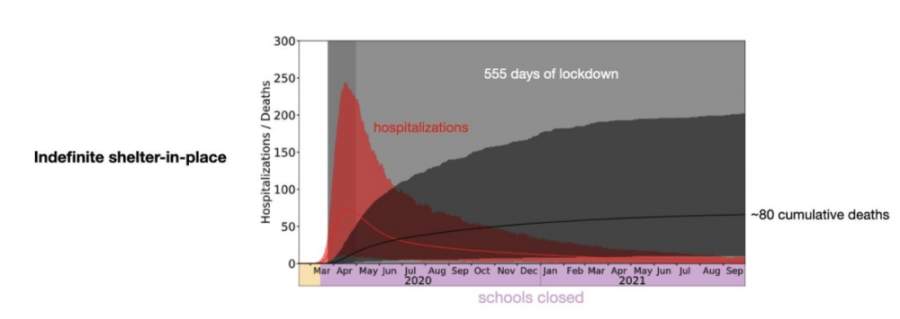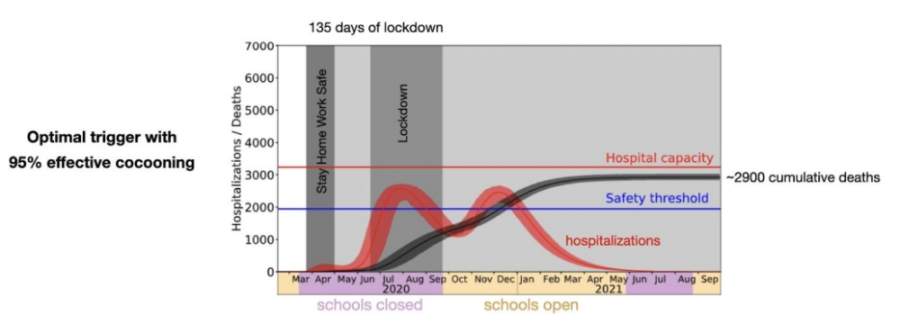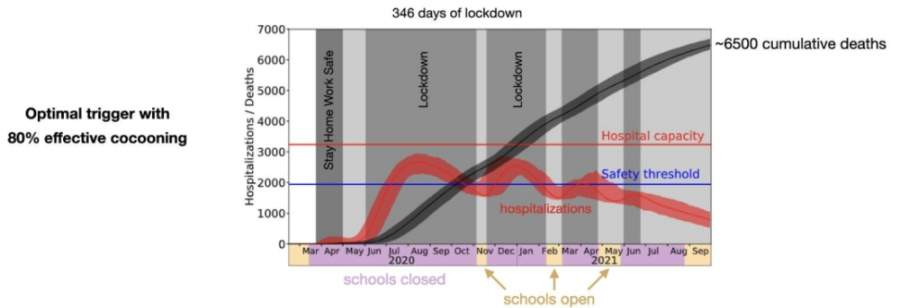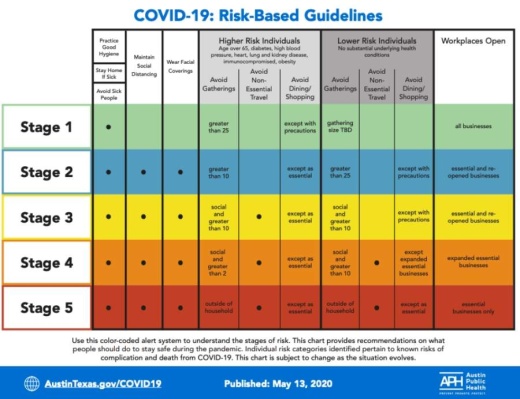The risk levels range from the less severe, Stage 1, to the most extreme, Stage 5. Austin-Travis County has been placed right in the middle at Stage 3, interim Health Authority Dr. Mark Escott said May 14.
At Stage 3, local health officials still recommend everyone maintain social distancing and wear face coverings. For higher risk individuals, such as elder and immunocompromised populations, Stage 3 guidelines recommend avoiding all social gatherings and groups of people greater than 10, nonessential travel, dining out and shopping, “except as essential.” Lower-risk populations without underlying health conditions are advised to practice much of the same; however, Stage 3 greenlights nonessential travel, dining out and shopping as long as precautions are taken, even with a countywide stay-home order in place through June 15.
Escott said the new guidelines attempt to help the economy while protecting public health. He said following guidelines could help the community avoid a surge in cases and overwhelming the local health care system and that the staged approach will continue for the foreseeable future. Escott said he remains hopeful that the community could reach Stage 1 and beyond but said it will no happen any time soon.
“To go beyond Stage 1 requires a vaccine [that is publicly available],” Escott said. “The earliest vaccine would be a year from now.”
Escott said the community is engaged in the same mission: balancing the public’s health and safety and maintaining a strong economy. However, over the last few weeks, local and state officials have sent mixed messages regarding that mission. The governor continues to relax statewide restrictions and has said that "local authorities fully understand" they have the power to implement tighter stay-home restrictions as they see fit. However, days after Austin-Travis County extended its stay-home order, Texas Attorney General Ken Paxton threatened to sue local leaders, calling the restrictions "unconstitutional and unlawful."
Local regulations under attack
A recent study from Philadelphia-based Drexel University’s Urban Health Collective shows Austin-Travis County’s stay-home order, which began March 25, saved 4,988 lives and kept 45,898 people out of the hospital over a 45-day period. The same study, which uses epidemiologists’ models available through the New York Times, estimates that a 60-day period of the same behavior would save a total of 5,741 lives and keep 54,908 people out of the hospital.
On May 1, with the green light from Texas Gov. Greg Abbott, restaurants, malls and movie theaters across the state, including Austin, began reopening with capacity restrictions. Similarly, on May 8, barbershops and hair salons began reopening their doors. On May 18, gyms will begin reopening as well.
Gov. Abbott has said face coverings are no longer necessary and forbade local jurisdictions from issuing civil or criminal penalty to citizens who choose to not wear them.
Austin Mayor Steve Adler said the process to reopen the economy began sooner than he would have liked and that moving the community toward a restart will, “by definition,” result in a surge of infections. As barber shops and salons began to reopen May 8, Adler and Travis County Judge Sarah Eckhardt issued extended stay-home orders—Austin’s expires at the end of May, Travis County’s by June 15—that further prohibit nonessential travel and re-emphasize that face coverings are mandatory even though the mandate cannot be enforced through criminal or civil penalty.
This caught the attention of Texas Attorney General Ken Paxton, who told Austin-Travis County leaders that their stay-home orders’ “unconstitutional and unlawful restrictions” were illegal and exceed the powers of the city and county. In March, the Texas governor continually delayed the decision to issue a statewide stay-home order and said such decisions should be determined by local jurisdictions, such as cities and counties.
“As local officials fully understand, local officials have the authority to implement more strict standards than what I, as governor, have ordered here in Texas,” Abbott said during a March 22 news conference. “They already have the full authority at the local level to implement those stricter standards. If they choose to do so, I will applaud them for doing so.”
Adler said the attorney general’s letter represents the first “real politicization” of the pandemic’s crisis and that he would not follow Paxton “down that road.” Adler said he is confident that the city and county’s orders were consistent and complementary to what the governor has said.
Necessity of a continued cocooning strategy
Models released by The University of Texas researchers in April show a continued necessity for social distancing and stay-home orders.

Lauren Meyers, an integrative biology professor at the University of Texas at Austin who has led the coronavirus modeling on which city officials have relied heavily, recommended maintaining a lockdown to fully limit the number of hospitalizations and deaths.
Meyers said permanently relaxing the stay-at-home could mean a surge of hospitalizations and deaths, levels
 of which could overwhelm the health care system. In this scenario, Meyers’ models show hospitalizations peaking sharply from late July to early August at roughly 6,000; hospital system capacity is just over 3,000. Hospitalizations would decrease substantially in late August before almost completely fizzling out by year’s end. The same models show deaths peaking between October and November at 2,900.
of which could overwhelm the health care system. In this scenario, Meyers’ models show hospitalizations peaking sharply from late July to early August at roughly 6,000; hospital system capacity is just over 3,000. Hospitalizations would decrease substantially in late August before almost completely fizzling out by year’s end. The same models show deaths peaking between October and November at 2,900.Meyers said such a scenario would be “catastrophic” to the health care system.
Meyers also projected outcomes of phased-in lockdowns and additional measures to protect vulnerable senior citizens and other high-risk populations. Meyers used the term “cocooning” to describe protecting the community’s most vulnerable from person-to-person interactions amid a wider reopening of society.
At 95% effective cocooning, the models predicted another lockdown could be necessary between mid-June and mid-September. Hospitalizations would peak at just under 3,000 in
 early August but would not overwhelm the hospital system. The models show a similar peak in hospitalizations by mid-December before trending downward and fizzling out by June 2021. Deaths would still reach 2,900, but it would take longer—until March 2021—to reach that number.
early August but would not overwhelm the hospital system. The models show a similar peak in hospitalizations by mid-December before trending downward and fizzling out by June 2021. Deaths would still reach 2,900, but it would take longer—until March 2021—to reach that number.At 80% effective cocooning, Meyers’ models paint a grim portrait. To avoid overwhelming the health care
 system, the community would need a lockdown between June and November, followed by another lockdown from mid-November to mid-January, another lockdown from early March to late April 2021 and a final lockdown in June 2021. This model shows three waves of hospitalizations—early August, January and late April 2021— before slowing down after September 2021; deaths would continually rise through September 2021, peaking at 6,500.
system, the community would need a lockdown between June and November, followed by another lockdown from mid-November to mid-January, another lockdown from early March to late April 2021 and a final lockdown in June 2021. This model shows three waves of hospitalizations—early August, January and late April 2021— before slowing down after September 2021; deaths would continually rise through September 2021, peaking at 6,500.“If you say our goal is to minimize deaths and minimize hospitalizations, the answer will be ... just [to] stay fully locked down or as locked down as you can for the longest period of time,” Meyers told Austin City Council in April.





